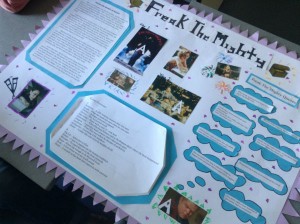
Ufuk Yagci is the Educational Technology Coordinator at MEF International School in Istanbul, Turkey
This is the second of a two-part article about integrating technology in the PYP learning environment in upper elementary. The first part illustrated some samples of a piloted iPad programme in MEF International School in Turkey.
With the integration of technology in the classroom, special focus was given on learning where technology has been a tool and enabler in providing the student community with a basis for enhancing their way of thinking and learning.
Some additional outstanding samples of this technology integration in the PYP are shared below.
Slow motion video analysis: With Ubersense application available both on IOS and Androids, physical education teachers can record, analyze and improve the students’ performances by viewing and zooming in on frame-by-frame playbacks. Students can analyze their moves and improve by viewing and comparing videos side by side. With this implementation, the students had the opportunity for practical learning (critical thinking, problem-solving, creativity, collaboration and communication skills) and life skills (flexibility, initiative, social skills, productivity and leadership) of the 21st century skills.
![]() Integrate technology with visual arts: Students created avatars using technology with the help of “buildyourwildself.com”. They combined human and animal parts of the body using technology and created their collage artwork with their avatars. This project made the theme surrealism more concrete for the students as they enjoyed working on their piece of artwork. They were introduced to the idea of using avatars instead of using their own photos, which had been a part of the digital citizenship program. They practiced risk-taking, creativity, being open-minded and reflective during this implementation.
Integrate technology with visual arts: Students created avatars using technology with the help of “buildyourwildself.com”. They combined human and animal parts of the body using technology and created their collage artwork with their avatars. This project made the theme surrealism more concrete for the students as they enjoyed working on their piece of artwork. They were introduced to the idea of using avatars instead of using their own photos, which had been a part of the digital citizenship program. They practiced risk-taking, creativity, being open-minded and reflective during this implementation.
Digital storytelling: Have your students created and designed their own digital stories? Here is an outstanding example of a digital story created by one of our English Language Learners students. He has written the story, drawn the background pictures and chosen the music for his work. He had the opportunity to build his English language skills as well as practicing literacy skills, creativity, risk-taking, thinker, reflective and communication skills with this project.
Book reviews & analysis: Grade 6 students read and studied the book Freak the Mighty by Rodman Philbrick. At the end of their unit they prepared a poster reflecting what they have learned as well as creating a movie trailer of the book. They have used their creativity in creating content for the posters. They also created digital contents for the posters and linked their digital content to their posters with the use of Aurasma, an augmented reality application that is free and available on all mobile platforms. Here is an outstanding example of one of the trailers for Freak the Mighty where students prepared the script by acting out the scenes.

Grade 5 students chose a country for their Poverty unit of inquiry and each student conducted his or her own research about poverty in the country chosen. They created their own movies where they presented their research and used Aurasma in integrating their work on a world map, which was displayed to the whole primary school
Several grade 4 students started creating book review trailers based on the books that they have read and they integrated the trailers to QR codes, which are placed on the shelves of our library. They used Tellagami to create avatars and built their trailers in iMovie. The trailers are audited for content as they have to meet the criteria set by the school librarian prior to taking their place on the library shelves.
Students practiced their research, literacy skills as well as creative, thinker, risk-taking, inquiry, reflective, communicator, principled, balanced, caring, open-minded, knowledgeable learner attributes in these projects.
More ideas of technology integration: We have practiced posting some student work and digital content on the teacher sites’ pages. This exercise can be expanded by giving the responsibility of class page and class bulletin creation of the week to each student at a certain period of the year and asking the classmates to offer both critical and encouraging comments on this class blog. This project can help students build their skills on becoming a digital citizen as well as practicing their communication and caring skills as they are contributing to the blog with their comments.
In the past two years we had the opportunity to collect the content-rich digital contents through the integration of technology in the classroom. In the near future, we will be focusing more on building digital portfolios where we would like to combine all the content on a digital platform.
—
Ufuk has implemented Google Apps for Education and BYO (bring your own) iPad Projects at MEF International School in the past two years. She is passionate about educational technology and is working on the integration of technology that will add value on the teaching and learning environment together with the teachers and students of MEF International School Community.

